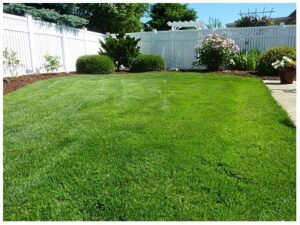How Healthy, Irrigated Landscapes
Keep Our Planet Cool
Climate change is a hot topic (no pun intended) among green industry professionals right now. And it was the theme of this year’s National Lawn Care Month.
To help educate the public about the important role healthy lawns and landscapes play in mitigating the negative effects of climate change, the National Association of Landscape Professionals (NALP) has released a new video.
Check it out:
Caring for the Planet
The easiest way to sequester carbon is through photosynthesis. So the more plants, trees and grass, the more carbon is removed from the air — and the more oxygen is produced. In addition, proper landscaping – with trees that provide both windbreaks and shade — saves energy by keeping homes warm in winter and cool in summer.
According to Britt Wood, NALP CEO, many homeowners are unaware of the positive impact they can have simply by adding plants and trees to their landscape and maintaining a healthy lawn. To this end, smart irrigation systems can be a major component in an overall strategy to protect the planet. Not only does smart irrigation save precious water resources, but it helps ensure that residential landscapes remain strong and healthy, optimizing their carbon-sequestering capabilities.
Homeowner Tips

Carbon-Capturing Lawns
A 2018 study by a University of Wisconsin scientist reveals that lawns may act as a secret weapon against climate change. In an analysis of soil samples Dr. Carly Ziter found that the typical American lawn is more effective at capturing carbon than natural, untouched ecosystems.
She is unsure why this is so, but speculates that it could be due to lawn care practices (e.g., mowing). However, Dr. Ziter emphasized that her study only compared the soil of lawns and natural environments, not the plants that may capture carbon aboveground.
Therefore, the effectiveness of carbon-capturing soil could potentially be offset by the carbon emissions required to maintain the lawns with gas-powered equipment.
Source: The New York Times
You can remind your customers of the important role they play in combatting climate change by offering them a few helpful tips:
![]() Add more trees and shrubs to sequester carbon, produce oxygen and filter the air.
Add more trees and shrubs to sequester carbon, produce oxygen and filter the air.
![]() Plant in the right spots to block prevailing winds and provide your home with energy-saving shade.
Plant in the right spots to block prevailing winds and provide your home with energy-saving shade.
![]() Select plants that are appropriate to your particular climate and location. Incorporate hydrozones in your landscape design to maximize irrigation efficiency.
Select plants that are appropriate to your particular climate and location. Incorporate hydrozones in your landscape design to maximize irrigation efficiency.
![]() Keep your lawn and plants healthy to capture more carbon and effectively filter storm water. Take advantage of smart irrigation technology – including weather stations with ET controllers, soil-moisture sensors, rain and wind sensors — to ensure optimal health for your residential landscape. Homeowners who are serious about changing their impact on the planet should explore these innovations to reduce water usage, save money, and preserve our precious resources.
Keep your lawn and plants healthy to capture more carbon and effectively filter storm water. Take advantage of smart irrigation technology – including weather stations with ET controllers, soil-moisture sensors, rain and wind sensors — to ensure optimal health for your residential landscape. Homeowners who are serious about changing their impact on the planet should explore these innovations to reduce water usage, save money, and preserve our precious resources.
Switch to Electric
The Electric Power Research Institute claims that replacing half of our gas-powered lawn mowers with electric models would have the same emissions-reducing effect as removing two million vehicles from the road.
So your customers may wish to consider switching to an electric-powered mower. Not only are electric mowers better for the planet, but they also are quieter, easier to maneuver, and less costly to maintain.
However, because they require either a cord or a limited-capacity battery, they work best on flatter, smaller yards (one-half acre or less). Large or challenging terrains with dips and slopes still require gas-powered mowers for optimal results.
But that may change. As consumers continue to demand greener alternatives, electric mower technology will no doubt evolve to include more powerful units with advanced capabilities.
—Article Continues Below—

Landscape contractors, also, are increasingly switching over to all-electric commercial-grade equipment. They find that electric equipment is cheaper to maintain and saves on time and labor, because workers are no longer stopping to refuel. And there’s no learning curve.
In addition, landscapers who’ve made the switch report that their customers have responded very favorably to the quieter motors and environmental benefits that the electric fleets offer.
Want More?
For additional resources regarding healthy landscapes and climate change, visit the NALP website.
Sources:
Featured Image: Pixabay
Irrigation and Green Industry
Cleveland Banner
CNet
Lawn & Landscape






